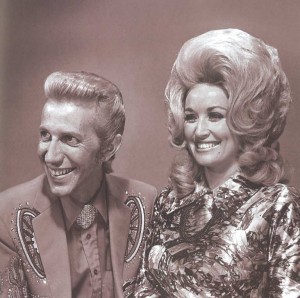When Dolly's mother took a box of rags that someone had given her and sewed them into a patchwork coat of love for her daughter, she didn't know she was setting her on a path that would become one of the most beautifully woven tapestries in the history of American music.
Dolly began songwriting at the tender age of five and has been on a magical journey of melody and rhyme ever since. Songwriting is part of the fabric of who Dolly is. For songwriters, some songs can take years to write, while others can be crafted in just a few hours. However, there are those special few that are woven in what seems to be a moment's time. Dolly's beloved "Coat of Many Colors" is one such song.
The year was 1969, and she was on tour with country music legend Porter Wagoner, who was widely known for his iconic rhinestone-clad stage clothes. She was riding on the tour bus when the inspiration for "Coat of Many Colors" overcame her. Ironically, the only paper available to her was Porter's dry cleaning receipts from his designer, one-of-a-kind coats, so she grabbed a pen and started writing! The song that poured out of her soul that day was about her own one-of-a-kind coat; a coat that gave her determination and wrapped her with confidence in the riches of a mother's love.
As the song says, Dolly's mother told her the Old Testament story of Joseph and his coat of many colors. Just like Joseph rose above the cruelty of others in his youth and went on to achieve his purpose in life, Dolly rose above the scoffers in the schoolyard and lives her life to encourage others to rise above their circumstances and to dream more...and it all started with a box of rags and a mother's love.
[masterslider id="16"]
Footage courtesy of Country Music Hall Of Fame And Museum Nashville
Dolly Parton performs "Coat Of Many Colors" after her induction to the "Country Music Hall Of Fame." Alison Krauss & Union Station were on hand during the ceremony to lend their beautiful talents to the performance.
Artist illustration by Lacinda Smith.
Dolly was recognized as being part of the 'Vocal Event of the Year' (the category name was changed to 'Musical Event of the Year' in 2005) at the Country Music Association's (CMA) annual awards show for her song "I will Always Love You," released as a duet with Vince Gill on her album "Something Special."
The song, "I Will Always Love You," has had a long history of success for Dolly and for the artists who have covered it (most famously Whitney Houston). It was originally written by Dolly as a thank you to Porter Wagoner, her long time singing and television partner because she had decided to leave the partnership. Dolly said,
"It's saying, 'Just because I'm going don't mean I won't love you. I appreciate you and I hope you do great and I appreciate everything you've done, but I'm out of here…’ And I took it in the next morning. I said, 'Sit down, Porter. I've written this song, and I want you to hear it.' So I did sing it. And he was crying. He said, 'That's the prettiest song I ever heard. And you can go, providing I get to produce that record.' And he did, and the rest is history."
The Dolly and Vince collaboration of "I Will Always Love You" was also honored with a GRAMMY nomination and a TNN/Music City News nomination for Vocal Performance of the Year and ultimately reached number 15 on the country charts.

Throughout Dolly’s seven-year stint on "The Porter Wagoner Show," she and Porter reigned supreme as one of country music’s most popular duos. However, the little blonde with the powerhouse voice had set her sights on a solo career. As she set forth on her path to make her dreams come true, it would mean leaving the show--and her duet partner. Tension mounted behind the scenes, leading Dolly to ask to leave the show. Her decision came two years later than she initially agreed to stay.
In 1974, Dolly wrote, "I Will Always Love You," as her own unique way of saying goodbye to Porter as their professional relationship came to an end. When Dolly first played the song for Porter, he began crying and uttered,
"That’s the prettiest song I ever heard. And you can go, providing I get to produce that record."
Wagoner followed through on his promise, and the album consequently went to No. 1 on the country charts.
Dolly’s second performance on the hit musical variety show 'Hee Haw' came in 1972. She performed her 1971 hit song 'Coat of Many Colors' and joined Porter Wagoner on the duet 'The Right Combination.'
'Dolly Day' or 'Dolly Days' began in 1970. Dolly credits Porter Wagoner as having a hand in the success of the first event and the production of the live album, "A Real Live Dolly," she recorded during the first Dolly Day. She said,
"He insisted that the event be produced as a live album, and he arranged for many well-known Nashville musicians to be a part of it. The album was a success and it made me very proud."
Many festivities were planned, including a Dolly Parade with Dolly as the grand marshal. The annual homecoming event is hosted in her hometown of Sevierville, Tenn.